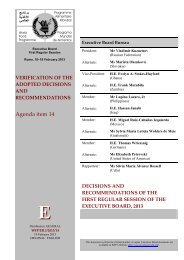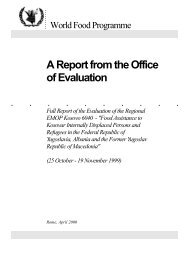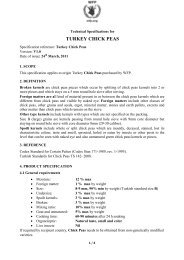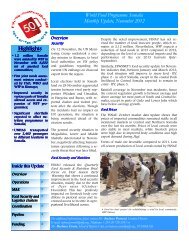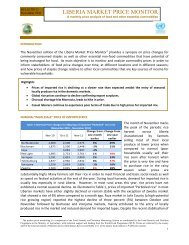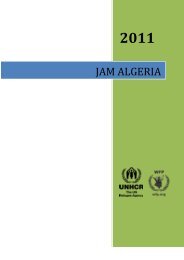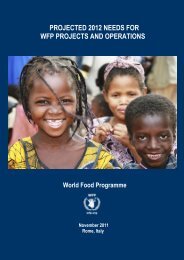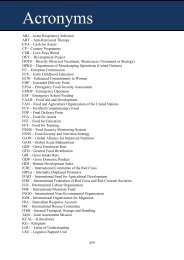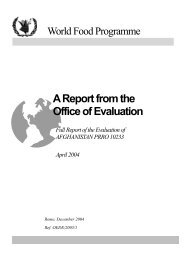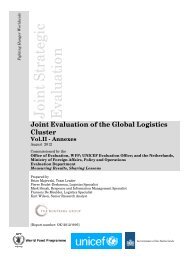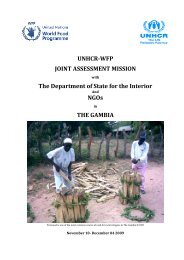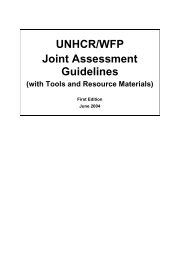The Hunger Tree
The Hunger Tree
The Hunger Tree
Create successful ePaper yourself
Turn your PDF publications into a flip-book with our unique Google optimized e-Paper software.
<strong>The</strong> <strong>Hunger</strong> <strong>Tree</strong><br />
Students and Teachers<br />
<strong>The</strong> World Food Programme - Fighting <strong>Hunger</strong> Worldwide<br />
Resources for<br />
Students & Teachers<br />
www.wfp.org/students-and-teachers | twitter.com/wfp_students | facebook.com/WFPstudents<br />
Classroom<br />
Activities<br />
<strong>The</strong> <strong>Hunger</strong> <strong>Tree</strong><br />
A lesson exploring the root causes of hunger<br />
Age Range: Grades 4-6<br />
Subjects: Social Studies & Language Arts<br />
Adapted from Kerpelman (2007), “Possible Selves <strong>Tree</strong>” activity in the Relationships Smarts Plus curriculum;<br />
distributed by the Dibble Institute in conjunction with the Alabama 4-H War on <strong>Hunger</strong> and Universities Fighting<br />
World <strong>Hunger</strong> at Auburn University<br />
Overview<br />
Critical thinking, making connections, visualisation of problems, collaborative learning.<br />
This activity uses the image of a tree to help students understand the problem of “hunger,” which may seem overwhelming<br />
and impossible to change at first. This activity helps young people think through the problem and why it occurs. It will also<br />
encourage them to think together about actions that can be taken to help reduce the problem of hunger.<br />
Aims & Objectives<br />
• To encourage students to think about global and domestic hunger, and the differences between the two<br />
• To increase students’ awareness of hunger-related problems<br />
• To increase students’ awareness of the multiple solutions for addressing hunger-related problems<br />
• To help students understand the connections between hunger and poverty<br />
Materials<br />
• Copies of tree template and hunger notes for the entire class<br />
• One piece of poster board with the outline of a tree drawn on it<br />
• Markers, crayons, and/or colored pencils<br />
1
Instructions<br />
Students and Teachers<br />
<strong>The</strong> World Food Programme - Fighting <strong>Hunger</strong> Worldwide<br />
Resources for<br />
Students & Teachers<br />
www.wfp.org/students-and-teachers | twitter.com/wfp_students | facebook.com/WFPstudents<br />
Classroom<br />
Activities<br />
1. Introduce hunger to the class by using the information found on the WFP website:<br />
http://www.wfp.org/students-and-teachers/teachers/hunger-101<br />
2. Break students up into groups of 3-4 and pass out the tree templates.<br />
<strong>The</strong> <strong>Hunger</strong> <strong>Tree</strong><br />
• Groups should be encouraged to articulate the ways in which hunger affects both individuals and society,<br />
and write them on the tree trunk.<br />
• Ex. <strong>Hunger</strong> makes it difficult for children to concentrate in school.<br />
• Second, have students discuss the possible causes of hunger and write them on the roots of the tree.<br />
• Ex. Poverty, lack of access to food, conflict/war, etc.<br />
3. Next, have students brainstorm possible actions to take to help solve the problem of hunger and write them on the<br />
leaves of the tree.<br />
• Ex. Have a food drive, an awareness activity, fundraising activity, etc.<br />
4. Come together as a class to make a large <strong>Hunger</strong> <strong>Tree</strong> for the entire class.<br />
• Have each group present their trees.<br />
• Write some or all of the causes, consequences, and actions on the large tree.<br />
• Keep the <strong>Hunger</strong> <strong>Tree</strong> in the class to remind students of what they learned.<br />
5. As you are wrapping up the activity, discuss the questions below with your class.<br />
6. Possible spin-offs into Language Arts might include letter writing, journalism, writing for a particular audience,<br />
persuasive writing, expository writing, etc.<br />
Discussion Questions:<br />
1. What actions, as a class, do you think we could take to reduce hunger in our community?<br />
2. What did you learn about hunger from this activity?<br />
3. Is there somthing we could do everyday to help make a difference?<br />
2
Name: _________________________________________<br />
Where <strong>The</strong> in <strong>Hunger</strong> the World: <strong>Tree</strong><br />
Horn of Africa<br />
Activity Sheet



